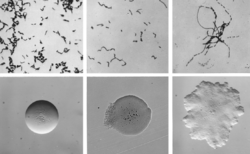Biology:Erysipelothrix
| Erysipelothrix | |
|---|---|

| |
| Cellular and colonial morphology of Erysipelothrix rhusiopathiae | |
| Scientific classification | |
| Domain: | Bacteria |
| Phylum: | Bacillota |
| Class: | Erysipelotrichia |
| Order: | Erysipelotrichales |
| Family: | Erysipelotrichaceae |
| Genus: | Erysipelothrix Rosenbach 1909 |
| Type species | |
| Erysipelothrix erysipeloides (Trevisan 1889) Rosenbach 1909
| |
| Species[1] | |
| |
Erysipelothrix is a genus of bacteria containing four described species: Erysipelothrix rhusiopathiae, Erysipelothrix tonsillarum, Erysipelothrix inopinata and Erysipelothrix larvae.[1][2][3][4] Additional species have been proposed based on DNA-DNA hybridization studies.[5][6] "The hallmark of Erysipelothrix is the presence of a type B cell wall, in which the peptide bridge is formed between amino acids at positions 2 and 4 of adjacent peptide side-chains and not, as in the vast majority of bacteria, between amino acids at positions 3 and 4."[3]
The best-known species within the genus is Erysipelothrix rhusiopathiae, which is the cause of erysipelas of domestic pigs, poultry and other animal species. In humans, E. rhusiopathiae infections are termed erysipeloid. Erysipelothrix tonsillarum has been described as a pathogen for dogs and has been isolated from the tonsils of healthy pigs and cattle.[7] Disease caused by E. inopinata or E. larvae has not been described.
Bacteria of genus Erysipelothrix are straight or slightly curved, slender, nonmotile rods that may exist singly, in V-shaped pairs, or in short chains. Some strains have a tendency to form long filaments. The bacteria are Gram-positive but can be mistaken for Gram-negative bacteria during analysis because they lose their staining easily. They are aerobic to facultatively anaerobic but not acid-fast.[8]
Phylogeny
The currently accepted taxonomy is based on the List of Prokaryotic names with Standing in Nomenclature (LPSN)[1] and National Center for Biotechnology Information (NCBI)[9]
| 16S rRNA based LTP_08_2023[10][11][12] | 120 marker proteins based GTDB 08-RS214[13][14][15] | ||||||||||||||||||||||||||||||||||||||||||||||||||||||||||||||||||||||||||||||||||||||||||
|---|---|---|---|---|---|---|---|---|---|---|---|---|---|---|---|---|---|---|---|---|---|---|---|---|---|---|---|---|---|---|---|---|---|---|---|---|---|---|---|---|---|---|---|---|---|---|---|---|---|---|---|---|---|---|---|---|---|---|---|---|---|---|---|---|---|---|---|---|---|---|---|---|---|---|---|---|---|---|---|---|---|---|---|---|---|---|---|---|---|---|---|
|
|
See also
References
- ↑ 1.0 1.1 1.2 A.C. Parte. "Erysipelothrix". List of Prokaryotic names with Standing in Nomenclature (LPSN). https://lpsn.dsmz.de/genus/Erysipelothrix.
- ↑ Takahashi, T., et al. (1987). Erysipelothrix tonsillarum sp. nov. isolated from tonsils of apparently healthy pigs.[yes|permanent dead link|dead link}}] IJSB 37(2) 166-68.
- ↑ 3.0 3.1 Verbarg, S., et al. (2004). Erysipelothrix inopinata sp. nov., isolated in the course of sterile filtration of vegetable peptone broth, and description of Erysipelotrichaceae fam. nov. IJSEM 54(1) 221-25.
- ↑ Bang, B.H.; Rhee, M.S.; Chang, D.H.; Park, D.S.; Kim, B.C. (2015). "Erysipelothrix larvae sp. nov., isolated from the larval gut of the rhinoceros beetle, Trypoxylus dichotomus (Coleoptera: Scarabaeidae)". Antonie van Leeuwenhoek 107 (2): 443–51. doi:10.1007/s10482-014-0342-x. PMID 25534074.
- ↑ Takahashi, T.; Fujisawa, T.; Tamura, Y.; Suzuki, S; Muramatsu, M.; Sawada, T.; Benno, Y.; Mitsuoka, T. (1992). "DNA relatedness among Erysipelothrix rhusiopathiae strains representing all twenty-three serovars and Erysipelothrix tonsillarum". International Journal of Systematic Bacteriology 42 (3): 469–473. doi:10.1099/00207713-42-3-469. PMID 1503975.
- ↑ Takahashi, Toshio; Fujisawa, Tomohiko; Umeno, Annu; Kozasa, Takashi; Yamamoto, Kinya; Sawada, Takuo (2008). "A taxonomic study on erysipelothrix by DNA-DNA hybridization experiments with numerous strains isolated from extensive origins". Microbiology and Immunology 52 (10): 469–478. doi:10.1111/j.1348-0421.2008.00061.x. PMID 18822080.
- ↑ Takahashi, T; Tamura, Y; Yoshimura, H; Nagamine, N; Kijima, M; Nakamura, M; Devriese, LA (March 1993). "Erysipelothrix tonsillarum isolated from dogs with endocarditis in Belgium.". Research in Veterinary Science 54 (2): 264–5. doi:10.1016/0034-5288(93)90071-M. PMID 8460272.
- ↑ Stackebrandt, E., et al. (2006). The Genus Erysipelothrix. Prokaryotes 4 492-510.
- ↑ Sayers. "Erysipelothrix". National Center for Biotechnology Information (NCBI) taxonomy database. https://www.ncbi.nlm.nih.gov/Taxonomy/Browser/wwwtax.cgi?mode=Undef&id=1647&lvl=3&keep=1&srchmode=1&unlock.
- ↑ "The LTP". https://imedea.uib-csic.es/mmg/ltp/#LTP.
- ↑ "LTP_all tree in newick format". https://imedea.uib-csic.es/mmg/ltp/wp-content/uploads/ltp/LTP_all_08_2023.ntree.
- ↑ "LTP_08_2023 Release Notes". https://imedea.uib-csic.es/mmg/ltp/wp-content/uploads/ltp/LTP_08_2023_release_notes.pdf.
- ↑ "GTDB release 08-RS214". https://gtdb.ecogenomic.org/about#4%7C.
- ↑ "bac120_r214.sp_label". https://data.gtdb.ecogenomic.org/releases/release214/214.0/auxillary_files/bac120_r214.sp_labels.tree.
- ↑ "Taxon History". https://gtdb.ecogenomic.org/taxon_history/.
External links
Wikidata ☰ Q18751993 entry
 |

